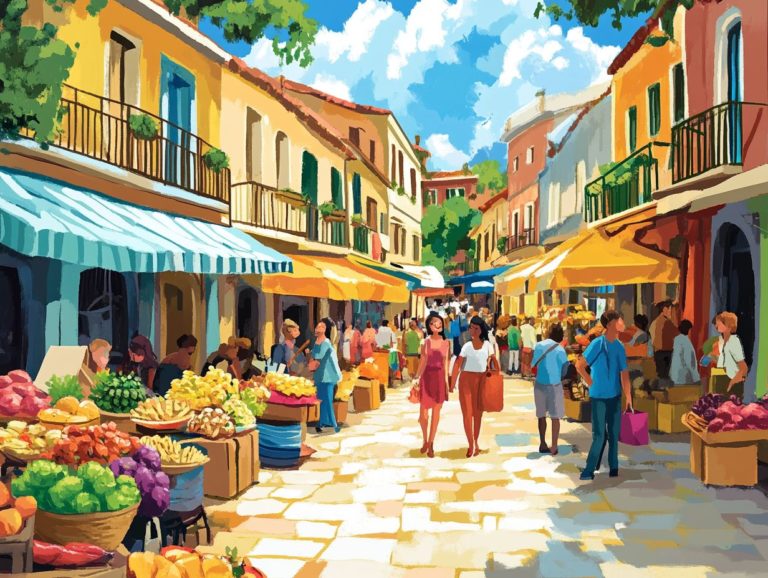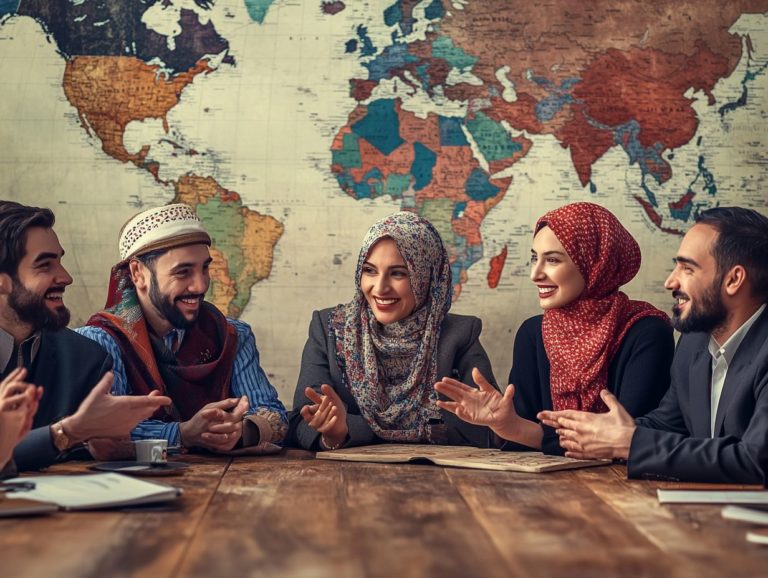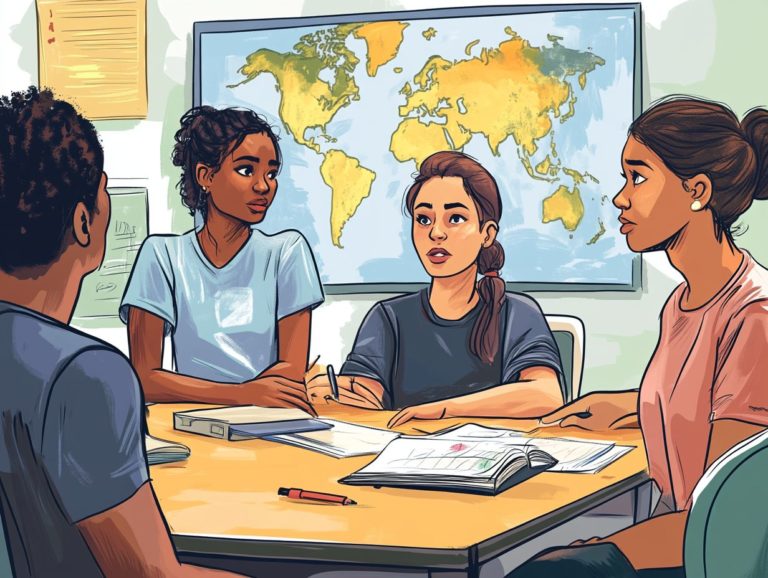7 global cultures and their unique languages
Language transcends mere communication; it serves as a rich mix of culture, history, and identity.
In this exploration of seven of the world’s most widely spoken languages, you ll uncover the captivating stories behind Mandarin Chinese, Spanish, Arabic, Hindi, Bengali, Russian, and Swahili. Each language possesses unique characteristics and rich traditions that shape the lives and interactions of millions around the globe.
Embark on this journey as you delve into how these languages have evolved, their cultural significance, and the intriguing connections they share.
Contents
- Key Takeaways:
- 1. Mandarin Chinese: The Most Widely Spoken Language in the World
- 2. Spanish: A Language of Romance and Influence
- 3. Arabic: A Language of Rich History and Culture
- 4. Hindi: A Language with Many Dialects and Variations
- 5. Bengali: An Official Language of India and Bangladesh
- 6. Russian: A Language of Literature and Power
- 7. Swahili: A Language of Trade and Communication in Africa
- How Do These Languages Reflect the Cultures They Belong To?
- Frequently Asked Questions
- What are the 7 global cultures and their unique languages?
- What makes these 7 cultures and languages unique?
- How many people speak each of these languages?
- Are these languages difficult to learn?
- What are some interesting facts about these languages?
- Can I learn more about these cultures through their languages?
Key Takeaways:
- Mandarin Chinese is the most widely spoken language in the world, with over 1 billion native speakers.
- Spanish is a language of romance and influence, spoken by over 500 million people in Spain and across Latin America and the U.S.
- Arabic, a language with a rich history, is known for its intricate writing system and influence on other languages.
1. Mandarin Chinese: The Most Widely Spoken Language in the World
Mandarin Chinese stands as the most widely spoken language worldwide, embodying the demographic strength of China while also reflecting cultural exchanges between countries fueled by globalization.
More people are interested in Mandarin because of rising tourism. Travelers discover that speaking Mandarin enriches their experiences and allows for deeper engagement with local customs and traditions.
As Mandarin becomes more integral to global business relations, language services tailored to its learners are on the rise, making it vital for anyone seeking career advancement.
This linguistic evolution isn’t limited to travel and commerce; Mandarin captures the rich tapestry of Chinese culture. Its intricate tones and characters provide a unique lens through which to view concepts that often resonate differently than in languages like Spanish or French.
By mastering Mandarin, you not only cultivate invaluable skills but also gain insight into the nuances of a civilization that has profoundly influenced many facets of global culture.
2. Spanish: A Language of Romance and Influence
Spanish, a language from the Romance family, has effortlessly transcended borders and cultural divides. It has established itself as a significant medium of communication in Spain and across Latin America and the U.S., where its growing presence mirrors the increasing cultural influence tied to Spanish-speaking nations.
You can trace this rich linguistic history back to the Latin spoken by the Romans. As globalization accelerates, Spanish becomes an essential tool that fosters connections among diverse communities.
By learning Spanish, you re not just unlocking new friendships; you’re also enhancing your travel experiences. Imagine engaging meaningfully with local cultures, diving into vibrant festivals, and savoring culinary delights.
The language serves as a bridge, connecting you to the rich tapestries of life in Spanish-speaking regions, ultimately enriching both your personal journey and the broader cultural understanding of those around you.
3. Arabic: A Language of Rich History and Culture
Arabic, a language steeped in rich history and cultural significance, connects you to various nations from the Middle East to North Africa. It serves as a pivotal language of commerce and diplomacy while showcasing diverse cultural practices inherent to the regions it inhabits, especially in the context of globalization.
As Arabic has evolved over centuries, it has given rise to numerous dialects, each reflecting unique local traditions and influences. This linguistic diversity enriches your communication within Arabic-speaking communities and extends its impact into global contexts.
The increasing number of tourists visiting Arab nations illustrates how understanding this language can enhance your cross-cultural interactions, fostering deeper connections. Its significance in education and language learning programs further highlights its role in cultivating linguistic abilities among both native speakers and those eager to explore its intricate beauty.
Start your language journey now and discover endless possibilities!
4. Hindi: A Language with Many Dialects and Variations
Hindi, one of India s official languages, is not just a way to communicate. It reflects the nation s rich cultures.
Its many dialects enhance your interactions and help you connect with local communities.
By learning Hindi, you can truly engage with cultural traditions, music, and cuisine.
Embracing the language positively impacts the tourism industry and deepens your appreciation for India’s cultural heritage.
5. Bengali: An Official Language of India and Bangladesh
Bengali is an official language in India and Bangladesh. It opens a window to explore rich cultural tales.
Bengali has deep historical roots and has evolved with influences from various cultures.
Its literary heritage includes captivating poetry, music, and folklore that resonate both locally and globally.
As globalization grows, interest in Bengali is rising. Learning it helps you appreciate Bengali art, cuisine, and festivals.
6. Russian: A Language of Literature and Power
Russian is famous for its rich literature and culture. It invites you to explore its complexities.
As you delve into Russian literature, works by Tolstoy and Dostoevsky may enchant you.
These stories offer insights into the Russian spirit and universal themes that connect us all.
The history of Russia, filled with turbulence and innovation, enriches your learning experience.
Tourists flock to Russia to witness its landscapes and literary landmarks, enhancing their journeys.
7. Swahili: A Language of Trade and Communication in Africa
Swahili is the common language of East Africa. It s a crucial tool for trade and connection.
With influences from African, Arab, and Portuguese cultures, Swahili has evolved significantly.
Learning Swahili deepens your understanding of local customs, enhancing your travel experience.
As globalization continues, Swahili s importance grows. By learning it, you connect across cultures in East Africa.
How Do These Languages Reflect the Cultures They Belong To?
The languages of Mandarin Chinese, Spanish, Arabic, Hindi, Bengali, Russian, and Swahili show how rich each culture is. Globalization shapes how these languages change and promotes cultural exchange, which influences tourism and sparks interest in learning languages.
Each language has unique stories and social practices developed over centuries. For instance, Mandarin Chinese embodies traditional Confucian values that shape relationships and social structures.
Spanish is spoken in many countries worldwide, incorporating indigenous influences and local customs. This creates a rich variety of dialects.
Arabic, known for its beautiful calligraphy and poetry, represents a vibrant heritage linked to religion and philosophy. As the world connects more, these languages blend together, encouraging meaningful conversations across cultures.
Language evolves as cultures interact. This change is marked by new words, shifts in pronunciation, and vocabulary changes, all while preserving the unique identities that make each language special.
What Are the Unique Features of Each Language?
Every language has features that define its structure and reflect the cultural nuances of its speakers. Consider the tonal variations in Mandarin, the romantic expressions in Spanish, the unique script of Arabic, the diverse dialects of Hindi, the poetic nature of Bengali, the literary depth of Russian, and the trade vocabulary in Swahili.
These features provide insight into the history, traditions, and values of the people who speak them. For example, the tonal nuances in Mandarin can convey emotions and reveal social dynamics. Similarly, Russian grammar rules indicate whether interactions are formal or informal, reflecting cultural context.
Arabic’s flowing script carries meaning and embodies a sense of identity and heritage. Each linguistic feature intertwines with communication practices, making the study of these languages an exploration of more than just words and rules.
How Have These Languages Evolved Over Time?
The evolution of Mandarin Chinese, Spanish, Arabic, Hindi, Bengali, Russian, and Swahili presents a fascinating story shaped by history, cultural exchanges, and globalization. This journey has led to the remarkable diversity and adaptability of these languages today.
Key milestones have influenced this transformation. For example, Spanish spread significantly due to colonization, as explorers and settlers carried their language to Latin America, leaving a lasting impact. Arabic thrived as a key medium for trade and scholarship during the Islamic Golden Age, thanks to contributions from traders and scholars.
Hindi and Bengali also have roots tied to migration and British colonial policies, which introduced new words and structures into their languages.
As time races on, technology is changing how we communicate! In our interconnected world, these advancements foster the blending of languages and cultures, enriching human expression.
What Are the Similarities and Differences Between These Languages?
Mandarin Chinese, Spanish, Arabic, Hindi, Bengali, Russian, and Swahili each have unique characteristics, yet they reveal fascinating similarities in their features and cultural reflections. This creates a variety of elements that represent human expression across different cultures.
When you explore their grammar, you’ll discover intriguing patterns. For instance, some languages use complex inflections changes in a word to express different grammatical categories while others, like Mandarin, rely on word order to convey meaning effectively.
Vocabulary also reflects cultural contexts. Specific terms often root deeply in traditions or lifestyles, showcasing how individuals from diverse backgrounds prioritize different aspects of their environments.
Phonetics, or the sounds of language, shows distinct sounds that influence not just pronunciation but also emotional expression. These variations highlight the intricate connection between language and culture, as speakers navigate their identities through linguistic choices, ultimately enriching global dialogue.
How Have These Languages Influenced Other Cultures and Languages?
The impact of languages such as Mandarin Chinese, Spanish, Arabic, Hindi, Bengali, Russian, and Swahili extends far beyond their native speakers. These languages play a crucial role in shaping and enriching other cultures through globalization, migration, and cultural exchanges.
Take Spanish in the Americas, for example. Its introduction has created a blending of cultures, reflected in culinary traditions and regional dialects that draw heavily from indigenous languages.
Arabic has left a lasting mark on scientific terminology and philosophical texts in various European languages during the Middle Ages.
Hindi has gained popularity in global cinema, bringing a wealth of colloquial expressions and cultural references that resonate with audiences worldwide. These examples show how languages blend into societies, creating connections and understanding.
What Are Some Common Phrases or Words in These Languages?
Every language offers a unique set of phrases and words that not only facilitate communication but also reveal the culture and traditions of its speakers.
Consider the greetings, expressions of gratitude, and colloquialisms found in Mandarin Chinese, Spanish, Arabic, Hindi, Bengali, Russian, and Swahili. These expressions often encapsulate the values and historical narratives of the communities that embrace them.
For example, the Spanish phrase ” C mo est s?” goes beyond a simple question of well-being; it embodies a culture that cherishes community and connection.
In a similar vein, “N h o” in Mandarin serves not just as a greeting; it emphasizes respect and social harmony, two fundamental pillars of Chinese society.
By exploring such phrases, you can deepen your understanding of your own linguistic heritage and the vibrant experiences that shape communication across cultures.
Frequently Asked Questions
What are the 7 global cultures and their unique languages?
The 7 global cultures and their unique languages include Chinese, Spanish, English, Arabic, Hindi, Bengali, and Portuguese. These are some of the most widely spoken languages in the world.
What makes these 7 cultures and languages unique?
Every culture here has a unique history that makes it special. They also have their own distinct grammar, syntax, and phonetics.
How many people speak each of these languages?
Chinese is the most spoken language in the world, with over 1.2 billion speakers. Spanish comes in second with over 460 million speakers, followed by English, also with over 460 million speakers. Arabic has over 319 million speakers, Hindi has over 341 million speakers, Bengali has over 228 million speakers, and Portuguese has over 215 million speakers.
Are these languages difficult to learn?
It depends on your native language and individual learning abilities. Some people may find certain languages easier to learn than others. However, with dedication and practice, anyone can become proficient in these languages.
What are some interesting facts about these languages?
Chinese is the oldest written language, with a history of over 5,000 years! Spanish is the official language of 21 countries.
English has more words than any other language, boasting over 1 million. Arabic is unique because it is written from right to left.
In Hindi, verb forms change based on the subject’s gender. Bengali is the national language of Bangladesh.
Portuguese, spoken in 9 countries, ranks as the 6th most spoken language worldwide!
Can I learn more about these cultures through their languages?
Absolutely! Language and culture are closely connected.
Learning a language deepens your understanding and appreciation of its culture. You ll discover traditions, customs, and values through the unique words and phrases of these seven global cultures!






